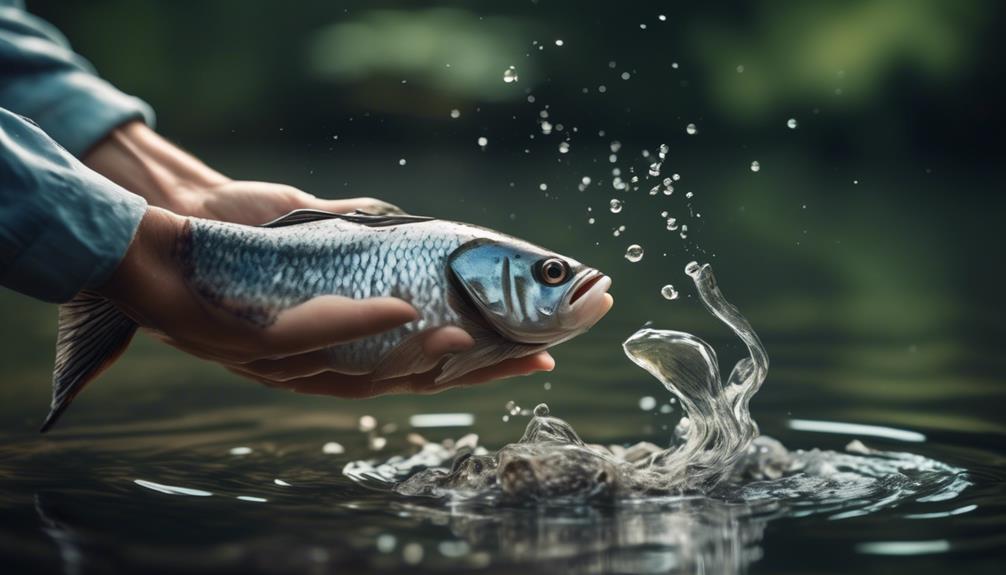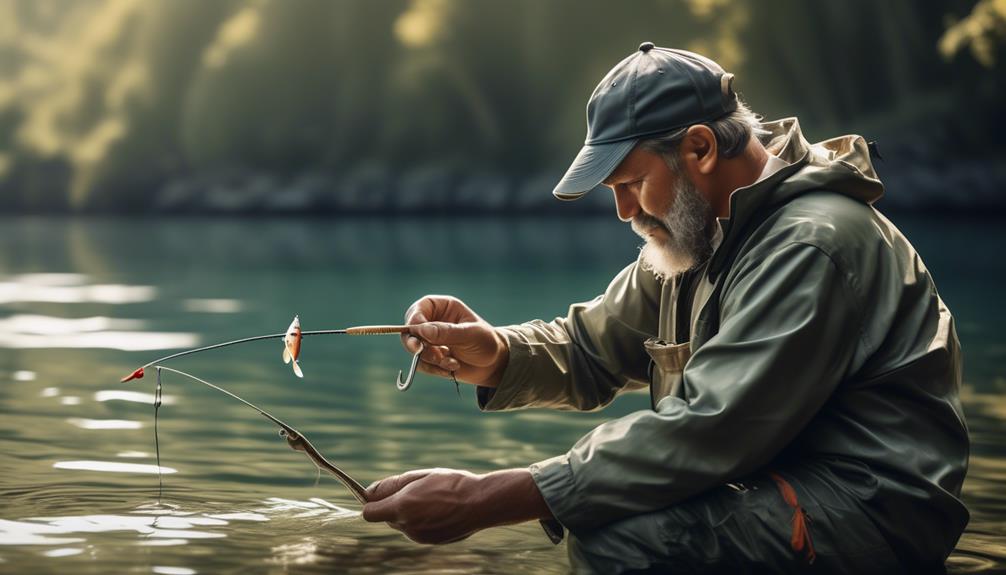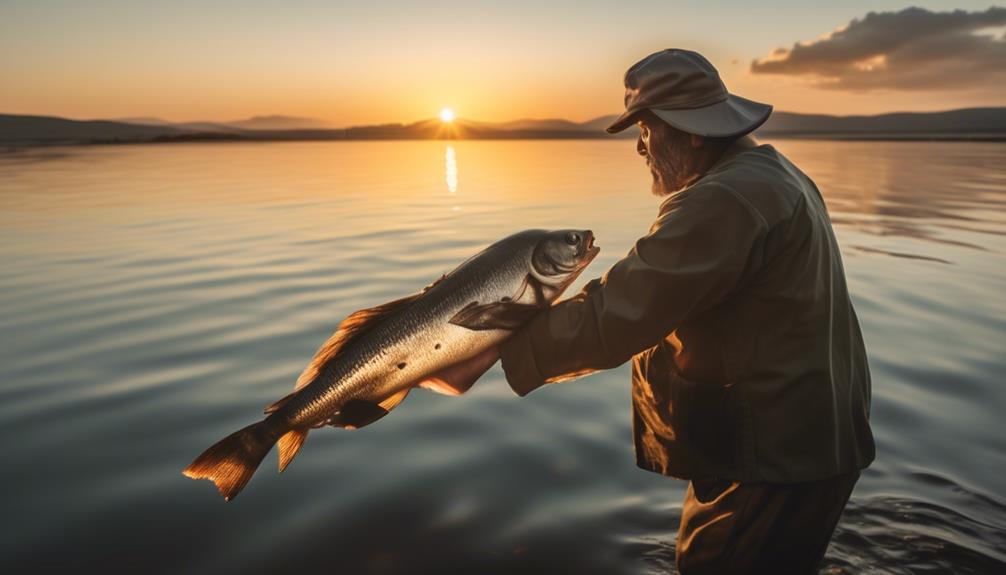Did you know that approximately 70% of recreational anglers practice catch-and-release fishing?
As an angler, you understand the importance of preserving fish populations and maintaining healthy ecosystems.
But do you know the most effective ways to teach catch-and-release ethics?
There are several key strategies that can help ensure that catch-and-release practices are carried out in a responsible and ethical manner.
Let's explore some effective techniques for teaching catch-and-release ethics that will benefit both fish and their habitats.
The Importance of Catch-and-Release Ethics
If you want to preserve fish populations and promote sustainable angling practices, understanding the importance of catch-and-release ethics is crucial. Ethical fishing practices are essential for the conservation awareness needed to maintain healthy fish populations. Sustainable angling isn't just about catching fish; it's about ensuring the long-term health and preservation of wildlife. By practicing catch-and-release, you can help protect fish populations and contribute to the overall balance of aquatic ecosystems.
When you practice catch-and-release, you're actively participating in wildlife preservation. It's about more than just releasing a fish back into the water; it's about understanding the impact of your actions on the environment and making choices that prioritize the well-being of fish populations. By releasing fish responsibly, you can help maintain the balance within ecosystems and contribute to the sustainability of angling for future generations.
Understanding Fish Handling Techniques
To ensure the well-being of the fish you catch, it's important to understand proper fish handling techniques. When practicing catch-and-release fishing, it's crucial to prioritize fish welfare and minimize stress during the handling process. Here are some essential fish handling techniques to keep in mind:
- Minimize Air Exposure: Reduce the time the fish spends out of the water. Limiting air exposure helps prevent stress and allows the fish to recover more quickly once released.
- Use Proper Handling Tools: Utilize tools like wet hands, rubberized nets, or dehooking devices to handle the fish gently and minimize damage to their delicate skin and scales. This can significantly reduce the stress experienced by the fish.
- Support the Fish Properly: When lifting the fish, support its body carefully to avoid causing harm. Cradling the fish horizontally can help distribute its weight evenly, reducing the risk of injury and stress.
Understanding and implementing these fish handling techniques can greatly contribute to the well-being of the fish you catch. By prioritizing fish welfare and handling stress, you can ensure that the fish have the best chance of survival after being released back into their natural habitat.
Selecting the Right Fishing Gear
When choosing fishing gear, consider the specific requirements of the fish species you intend to catch to ensure a successful and ethical catch-and-release process. Choosing appropriate equipment is crucial for practicing catch-and-release ethics. Different fish species have varying mouth structures, sizes, and behaviors, which necessitate different hook sizes, types, and bait. For instance, using circle hooks for species like catfish and tarpon can significantly reduce injury and mortality rates during catch-and-release.
Selecting the right fishing gear also involves considering the line strength, as using too heavy a line can tire the fish excessively, while too light a line may result in a prolonged fight that exhausts the fish. Additionally, the type of fishing rod plays a significant role in the successful release of the fish. For example, using a rod with a softer tip and more flexible action can reduce the risk of hooking deeply and increase the chances of successful hook removal.
Furthermore, the proper use of barbless hooks can facilitate easier hook removal, minimizing potential harm to the fish. When choosing lures, opt for those with single hooks rather than treble hooks to lessen the chances of causing extensive damage to the fish's mouth.
Educating on Proper Hook Removal
You can facilitate proper hook removal by gently and swiftly removing the hook from the fish's mouth using the appropriate tools and techniques. This is crucial for both hook safety and fish health.
Here are some essential tips for educating on proper hook removal:
- Use Pliers or Forceps: Always carry a pair of needle-nose pliers or hemostats to safely and quickly remove the hook. These tools help you maintain a secure grip on the hook, making the removal process smoother and minimizing potential harm to the fish.
- Minimize Handling: Limit the time the fish spends out of the water to reduce stress and potential injury. Keep the fish in the water as much as possible while removing the hook. If you must handle the fish, wet your hands to avoid damaging its protective mucus layer, which is crucial for its health.
- Practice Proper Technique: When removing the hook, gently and carefully back it out the same way it went in. If the fish has swallowed the hook deeply, consider cutting the line as close to the hook as possible, rather than pulling the hook out forcefully, which could cause internal injuries.
Emphasizing Safe and Gentle Handling
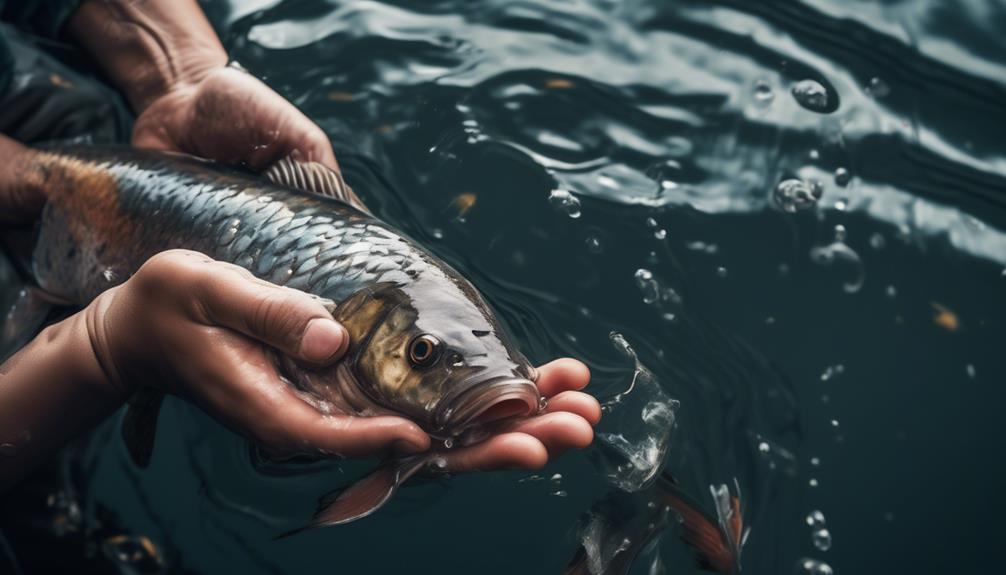
Consider using a gentle and secure grip when handling the fish to minimize stress and potential harm. Ethical angling involves not only catching the fish responsibly but also ensuring its safe and gentle release back into the water.
When handling the fish, wet your hands to avoid removing the protective slime layer that covers their scales. This layer is essential for their protection against bacteria and parasites. Grasp the fish gently but securely, supporting its weight properly to minimize any unnecessary pressure on its internal organs. Avoid squeezing or gripping the fish too tightly, as this can cause injuries. Additionally, try to keep the fish in the water as much as possible, especially for larger species, to ensure they can breathe properly.
When removing the hook, use a pair of long-nose pliers or a hook removal tool to facilitate a quick and gentle release. If the fish has swallowed the hook deeply, consider cutting the line rather than attempting to remove the hook, as this can cause significant damage. After the hook is removed, gently place the fish back into the water, supporting it until it swims away on its own.
Teaching Proper Fish Recovery Methods
To ensure the fish's optimal recovery after catch-and-release, gently support it in the water until it regains strength and swims away on its own. Proper fish recovery methods are crucial for the fish's health and well-being. After a challenging fight, fish need time to recuperate before returning to their natural habitat.
Here are some effective fish recovery methods to incorporate into your catch-and-release practices:
- Minimize Handling: Reduce the time you handle the fish. The more you handle the fish, the more stressed it becomes, impacting its recovery time. Minimizing handling helps the fish conserve energy and focus on recovery.
- Revive in Moving Water: If possible, position the fish facing into a gentle current. This allows oxygen-rich water to flow over its gills, aiding in its recovery. The current helps the fish regain its strength and equilibrium before swimming off.
- Properly Support the Fish: While waiting for the fish to regain its strength, gently support it in an upright position. This helps maintain the fish's balance and ensures it can breathe properly, aiding in a quicker recovery time.
Promoting Environmental Awareness
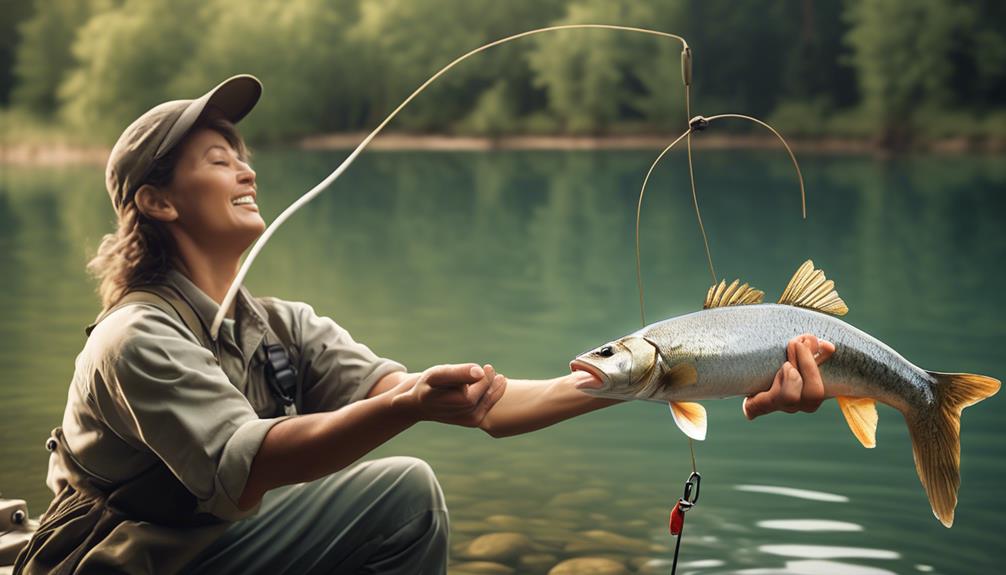
Promote environmental awareness by actively engaging in conservation efforts and educating others about the importance of protecting our natural resources. Environmental conservation is crucial to maintaining the delicate balance of our ecosystems. By actively participating in conservation projects, such as beach cleanups, tree planting initiatives, or wildlife habitat restoration, you can directly contribute to the preservation of our environment.
Additionally, educating others about the significance of wildlife preservation and the impact of human activities on natural habitats is essential. Encouraging responsible behavior, such as proper waste disposal and reducing plastic usage, can help minimize the harmful effects on wildlife and their habitats.
One effective way to promote environmental awareness is by organizing or participating in educational workshops and seminars focused on environmental conservation. These events can cover topics such as sustainable living, endangered species protection, and the importance of biodiversity. Through these initiatives, you can inspire others to take an active role in preserving the environment. Sharing information about local flora and fauna, as well as the potential threats they face, can also raise awareness about the need for wildlife preservation.
Furthermore, utilizing social media platforms and community outreach programs can amplify the message of environmental awareness. By sharing educational content and practical tips for sustainable living, you can reach a wider audience and encourage collective action towards environmental conservation.
Encouraging Responsible Angling Practices
After actively engaging in environmental conservation efforts and promoting awareness about wildlife preservation, it's important to also encourage responsible angling practices to ensure the sustainability of fish populations.
- Angler Education: Providing anglers with the knowledge and skills they need to practice ethical fishing is essential. This involves educating them about the importance of handling fish properly, using the right gear to minimize harm, and understanding local fishing regulations to prevent overfishing.
- Promoting Ethical Fishing: Encouraging anglers to embrace catch-and-release practices can significantly contribute to the preservation of fish populations. Teaching them how to properly release fish, minimizing their stress and injury, and using barbless hooks can make a substantial difference.
- Respect for the Environment: Instilling a sense of responsibility towards the environment in anglers is crucial. Emphasizing the significance of leaving fishing spots cleaner than they found them and minimizing their impact on aquatic habitats is essential for sustainable angling practices.
Frequently Asked Questions
What Are the Potential Long-Term Effects of Catch-And-Release Fishing on Fish Populations?
Catch-and-release fishing can have potential impacts on fish populations, especially if not done properly. Conservation strategies like using barbless hooks, minimizing fight time, and proper handling techniques can help reduce long-term effects.
It's important to consider the stress on fish and their ability to recover after being caught and released. By implementing these strategies, anglers can help ensure the sustainability of fish populations for future generations.
How Can Anglers Determine if a Fish Is Healthy Enough to Be Released After Being Caught?
To determine fish health before releasing, check for responsive movement, clear eyes, and intact fins. Avoid handling the fish excessively and use wet hands or a rubberized net. Support the fish in the water until it can swim away on its own.
Implementing these releasing techniques can help ensure the fish has a higher chance of survival after being caught.
Are There Any Specific Fish Species That Are More Susceptible to Injuries During Catch-And-Release Fishing?
Certain fish species are more prone to injuries during catch-and-release due to their behavior and physiology. Understanding this, conservation and education efforts should focus on teaching anglers about the specific vulnerabilities of these species.
What Are Some Common Mistakes That Anglers Make When Practicing Catch-And-Release Fishing?
When practicing catch-and-release fishing, anglers often make common mistakes that impact fish. Proper handling is crucial to minimize harm and support conservation efforts. Avoiding over-handling, using barbed hooks, and neglecting to wet hands before handling fish are common errors.
How Can Catch-And-Release Ethics Be Effectively Taught to Children and Young Anglers?
When teaching catch-and-release ethics to children and young anglers, engaging teaching methods and interactive activities are crucial. You can use hands-on demonstrations to show the proper techniques for handling and releasing fish. Incorporate games or role-playing scenarios to reinforce the importance of ethical fishing practices.
Conclusion
In conclusion, teaching catch-and-release ethics is crucial for preserving fish populations and maintaining healthy ecosystems. By emphasizing proper fish handling techniques, promoting environmental awareness, and encouraging responsible angling practices, anglers can make a positive impact on conservation efforts.
Remember to always prioritize the well-being of the fish and the environment, and share your knowledge with others to help spread the importance of catch-and-release ethics.
Happy fishing!
